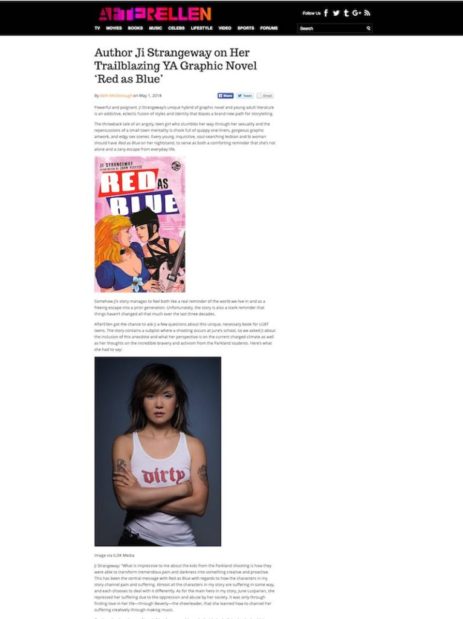Author Ji Strangeway on Her Trailblazing YA Graphic Novel ‘Red as Blue’
|
Powerful and poignant. Ji Strangeway’s unique hybrid of graphic novel and young adult literature is an addictive, eclectic fusion of styles and identity that blazes a brand new path for storytelling.
The throwback tale of an angsty, teen girl who stumbles her way through her sexuality and the repercussions of a small town mentality is chock full of quippy one-liners, gorgeous graphic artwork, and edgy sex scenes. Every young, inquisitive, soul-searching lesbian and bi woman should have Red as Blue on her nightstand, to serve as both a comforting reminder that she’s not alone and a zany escape from everyday life.
Somehow Ji’s story manages to feel both like a real reminder of the world we live in and as a freeing escape into a prior generation. Unfortunately, the story is also a stark reminder that things haven’t changed all that much over the last three decades. AfterEllen got the chance to ask Ji a few questions about this unique, necessary book for LGBT teens. The story contains a subplot where a shooting occurs at June’s school, so we asked Ji about the inclusion of this anecdote and what her perspective is on the current charged climate as well as her thoughts on the incredible bravery and activism from the Parkland students. Here’s what she had to say:
Ji Strangeway: “What is impressive to me about the kids from the Parkland shooting is how they were able to transform tremendous pain and darkness into something creative and proactive. This has been the central message with Red as Blue with regards to how the characters in my story channel pain and suffering. Almost all the characters in my story are suffering in some way, and each chooses to deal with it differently. As for the main hero in my story, June Lusparian, she repressed her suffering due to the oppression and abuse by her society. It was only through finding love in her life—through Beverly—the cheerleader, that she learned how to channel her suffering creatively through making music. On the other hand, one of June’s friends was unable to deal with the bullying he dealt with in school and instead of finding love—he sought power and self-esteem through the enjoyment of guns and killing animals. My story doesn’t judge what these characters go through or how they choose to transform pain, however, the kids in Red as Blue mirror the sickness of society and how the social values and environment cause them to act out. These kids are looking for leadership, for true role models and leadership because they are filled with unlived creative potential. Instead, the religiosity and oppressive environment they endured in the 1980s (when the story takes place) forced them to fend for themselves, for their own beliefs, and to battle for their true identity. In this sense, Red as Blue is a modern reminder of the Lord of the Flies, which to me, is an incredible allegory of children having to become their own leaders—modeling leaders who are actually children.” “This ties into the Parkland high school shooting in 2018 because finally, the kids in today’s society are voicing the lack of leadership where—in my opinion—society is currently being run in a Lord of The Flies kind of way. The Parkland students are calling out the adults for their lack of leadership. Leaders who do not father or parent our country, but behave childishly by expecting children to come up with solutions while continuing to ignore their cry for a better world; a world lead by true leaders. Drawing from my own reaction to the Colorado Columbine shooting of 1999, my first reaction as I watched in horror of the events unfold on the news was the idea that “this cannot be happening and should never happen again.” And this “never again” never happened—until I wrote this story to heal the past and until the Parkland incident happened. What’s inspiring about the Parkland kids is that they are the manifestation of what I hoped to achieve in telling a story about love and tolerance in Red as Blue; as well on how to channel dark energy. They have chosen love over power through creative activism, while our patriarchal society enforces power over love to tell them they are wrong. It is important to me to address this type these tough issues and violence through a love story. The two main characters in Red as Blue must find love—because as they heal—they also heal society. This is what we are all trying to do and that is why choose the path of love over power is necessary.” I also asked Ji what kind of impact she hopes Red as Blue will have on readers, and what she wants them to walk away feeling after they finish the story: “I’d like readers to walk away with many things from reading Red as Blue. Yet my greatest hope is they walk away with what the characters did after a very rough year at Paradise High School, which is they were transformed. I want readers to feel transformed. It is this energy that awakens us to the power of our creativity.” |
(View original Article)



